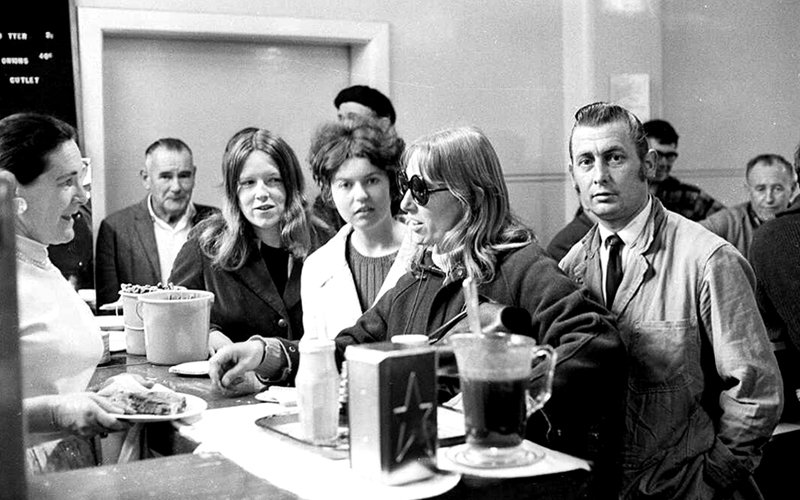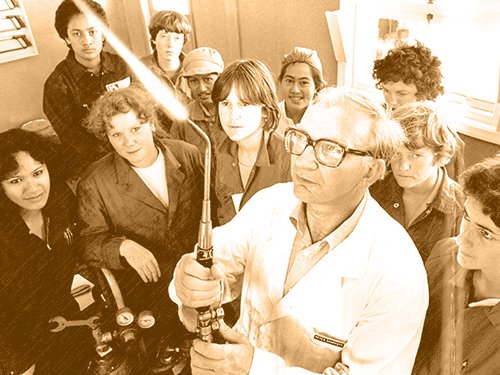Groups pushed for women’s entry into non-traditional careers and campaigned for pay equity and educational opportunities. Within this climate of discussion and activity, engineering schools began to consider what they could do to increase female enrolments.
Women in the workforce
By 1970, only a handful of women had graduated with engineering degrees from New Zealand universities. Women made up almost 30 percent of the workforce but were concentrated in professions such as teaching, nursing, shop and clerical work and food and clothing production – professions generally less well paid than male dominated professions of equivalent training and skill.
Two of the core demands of the women’s movement in New Zealand in the 1970s were equal pay for equal work and equal employment and education opportunities. This meant both fairer remuneration for sectors dominated by women, and opportunities for women to train for and enter traditionally male dominated work sectors.
Although the Government Service Equal Pay Act had passed in 1960 – ensuring equal pay for men and women in the same public service role – there was reluctance for the same to be passed for the private sector. It took a further 12 years of campaigning before the private sector Equal Pay Act was passed in 1972. In the ten years following, the average earnings for women shifted from 65 percent of what men earnt to 75 percent of what men earnt. The Equal Pay Act 1972 meant that women and men in the same role had to be paid the same, but did not address the inequity of lower pay in sectors dominated by women. That campaign would continue to be fought over the following decades.
Educational opportunities and gender stereotyping
Feminists also set their sights on increasing opportunities for women in education and gaining entry into, and promotion within, sectors dominated by men. This included many trades and professional sectors such as engineering. Although compulsory home science for girls was a thing of the past, fewer girls than boys chose to continue with maths and science subjects at high school. This effectively ruled them out of entering tertiary courses like engineering which required University Entrance (UE) maths and physics. In 1967 only 33 percent of girls took UE maths and 11 percent of girls took UE physics.
Feminists saw that social expectation and gender stereotyping began well before students were choosing elective subjects at secondary school. They argued that even very young children internalised social norms. This influenced the way they saw themselves, affecting their perception of what was expected of them and the nature of their potential. To counter this, women’s groups worked to make visible and break down gender roles. The Dunedin Collective for Women, and the Working Party on Sex-Role Stereotyping (set up under the Council for Equal Pay and Equal Opportunity) both analysed a series of books published by the Department of Education that were in use in all New Zealand primary schools as set texts for students learning to read. Their research found fewer female than male characters portrayed in the stories. Girls were often shown as passive and home centred, while boys were more likely to be adventurous, creative and independent. Women were almost exclusively presented in domestic situations, or as teachers.

Women's Liberation Front members ordering a meal at New City Hotel, Wellington. Photo: Dominion Post (Newspaper). Ref: EP/1970/3762/16-F. Alexander Turnbull Library, Wellington, New Zealand.
Feminism at established universities
Feminist groups were active at universities too. From the early 1970s, most campuses had a student feminist presence – including women’s groups on campus and feminist views and content published in student newspapers. Increasing numbers of women were enrolling at university. At University of Auckland in 1972 women made up 32 percent of the student body, up from 26 percent in 1965. Women’s participation in engineering courses sat around 2 percent, lagging well behind the numbers for law and medicine. The feminist ideas of gender equality and representation swirling around the universities in the 1970s slowly began to permeate engineering departments too. There was a genuine desire on the part of staff to recruit more women into the programme and increase the diversity of the school.
University of Auckland
From 1970, the engineering school at University of Auckland had been sending prospectuses to girls’ schools but did not take any further steps to attract female students until the mid-1970s. In 1969, University of Auckland graduate, Mike O’Sullivan, returned to take up a position as lecturer after completing his PhD at CalTech in the United States. At CalTech, Mike had seen several female engineering students and an active campaign to attract more. Ideas of social equity and opportunity had also extended to students of ethnic minority. In his first year back at Auckland, Mike recalled only one female engineering student in the whole faculty. In 1975, along with colleagues he formed a Women in Engineering Committee. The group included a representative from each department in the faculty and was led by Margaret Morton and Barbara Reilly from the Mathematics Department and himself and Margaret Blakeley (a research fellow in the Department of Theoretical and Applied Mechanics) from the School of Engineering. Together they set an initial target of 20 percent female enrolments in engineering. The group identified social factors, and a lack of knowledge of what engineering roles entailed as barriers to women’s entry. They worked to build relationships with schools and teachers who would champion maths and science for their female students.
Enginuity Day, begun in 1976 or 1977, was one of the committee’s first initiatives. The programme, still running today, is an open day for high school students to tour the engineering department and find out about the different specialisations. In its first years, Mike recalled around 20–30 girls attending. Relationships built with high school teachers were critical to the programme’s success. Mike remembered quite a few students from Epsom Girls Grammar enrolling in engineering due to the encouragement of science teacher, Susan Spencer.
Another initiative at the University of Auckland was the establishment of a Schools Liaison Committee in 1976. The committee was made up of a representative from each of the five departments of the engineering faculty, the Associate Dean of Engineering, University Liaison Officer and a representative from the Auckland Branch Committee of IPENZ. Its aim was to promote engineering as a career to secondary school students. The committee ran information sessions for careers advisors and contributed speakers and displays – including a women in engineering display – to career evenings at schools across Auckland. From 1982, the group made an effort to include a woman engineer as part of the team attending careers functions.
While these efforts did lead to a gradual increase in women engineering students through the 1970s, the results were still modest. During the years 1971–1981, 10 women on average enrolled to study engineering at the University of Auckland each year out of intakes of 200. In the years before, the average had been one or two female students.
Conclusion
The women’s movement raised public consciousness around issues related to women’s work and training opportunities. This set the scene for a flourishing of activity on the part of universities and IPENZ over the following decade.

Advocacy in the 1980s
In the 1980s, government campaigns encouraged women to consider non-traditional jobs. More women were attending university and enrolments in engineering moved from 2 percent to 12 percent.


